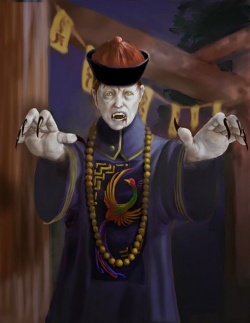Tibetan Zombies or 'Rolang'
Another mysterious rite is called rolang (the corpse who stands up). Traditions and ancient chronicles relate that, before the introduction of Buddhism into Tibet, it was practised by the Bonpo shamans during the funeral ceremony. However, the brief movement made by a dead body in such circumstances cannot be compared with what happens in the course of the horrible and grotesque tete-a-tete that Tibetan occultists depict.
There exist several kinds of rolang. These must not be mistaken for the trong jug rite which causes the "spirit" of another being to pass into a corpse and apparently resuscitate it, though the corpse is not animated by its original occupant.
One of these lugubrious rolang was described to me as follows by a ngagspa who said he had practised it himself.
The celebrant is shut up alone with a corpse in a dark room. To animate the body, he lies on it, mouth to mouth, and while holding it in his arms, he must continually repeat mentally the same magic formula, excluding all other thoughts.
After a certain time the corpse begins to move. It stands up and tries to escape; the sorcerer, firmly clinging to it, prevents it from freeing itself. Now the body struggles more fiercely. It leaps and bounds to extraordinary heights, dragging with it the man who must hold on, keeping his lips upon the mouth of the monster, and continue mentally repeating the magic words.
At last the tongue of the corpse protrudes from its mouth. The critical moment has arrived. The sorcerer seizes the tongue with his teeth and bites if off. The corpse at once collapses.
Failure in controlling the body after having awaked it, means certain death for the sorcerer.
The tongue carefully dried becomes a powerful magic weapon which is treasured by the triumphant ngagspa.
The Tibetan who gave me these details described most vividly the gradual awakening of the corpse. The first concious look which brightened its glazed eyes and its feeble movements slowly growing in strength until he became unable to prevent the agitation of the jumping monster and needed all his strength to hold it. He described his sensations when he could feel the tongue issuing from the mouth of the corpse and touching his own lips, and realized that the terrible moment had come when, if he failed to conquer it, the horrible being would kill him.
Had that fantastic struggle not been purely subjective? Had it not taken place during one of these trances which are frequently experienced by Tibetan naljorpas, which they also volutarily cultivate? I doubted and asked to see the tongue. The sorcerer showed me a desiccated blackish object which might have been a tongue, but it was not sufficient to prove the origin of the hideous relic.
Be that as it may, numbers of Tibetans believe that the rolang rite really takes place.
Beside corpses being revived by special rites, Tibetans believe also that any corpse is liable to rise suddenly and harm the living. It is for this reason that dead bodies are continually watched by someone who recites the liturgic words which prevent that sham ressurrection.
A trapa from Sepogon in the vicinity of the Salween told me the following story.
While still a boy novice, he hadaccompained three lamas of his monastery to a house where a man had died. There the lamas were to perform the daily rite for the dead till the day appointed to carry the corpse to the cemetery. At night they had retired to sleep in a corner of the large room where the body was kept, tied up in a seated posture with many scarves and swathed in clothes.
"The charge of reciting the magic formulas had been entrusted to me. In the middle of the night I was overcome with the continuous wearisome repetition and may have dozed a few minutes. A small moise awaked me, a black cat passed by the corpse and went out of the room. Then I heard a kind of cracking noise like tearing cloth, and to my horror, I saw the dead body moving and freeing himself from his bands. Mad with fright, I ran out of the house, but before I had escaped from the room I saw the ghost stretching out one hand and creeping upon the sleeping men.
"In the morning the three men were found dead; the corpse had returned to his place but the scarves were torn and the clothes lay on the floor around him."
Tibetans have great faith in such stories.
The touch of the rolang is mortal and the mischievous ghost does not fail to lay his hand on all who are within his reach. Only the lamas who perform the rites of the dead are said to know magic words and gestures which avert that danger, by controlling the corpse and causing it to sit back if it attempts to move.
We are also told of rolangs which escape from the house where they have revived and roam about the country. Again, others are said to disappear without leaving any trace.
One could fill numbers of books with the stories one hears about rolangs among the good people of Tibet.
